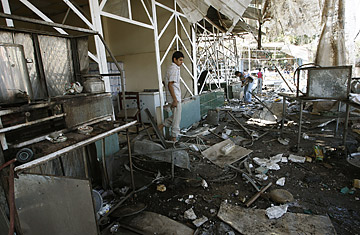
Iraqis look at the debris of several restaurants following a twin bombing when a car first detonated in the Sunni district of Adhamiyah in Baghdad, followed by a suicide bomber on November 10, 2008.
The tactic had been becoming increasingly rare in today's nominally safer Iraq. But on Monday, multiple bombings just minutes apart tore up parts of Baghdad during the morning rush hour. While alarming because there hadn't been a major attack for a while, the bombs that exploded in the predominantly Shi'ite neighborhood of Kasra are unlikely to herald a return to the bad old days, according to security officials. Al-Qaeda and other extremist groups, they say, have been severely weakened and are merely shadows of their former selves, too hamstrung to conduct extended campaigns of terror. (See pictures of Iraq's attempts to restore normalcy.)
There were conflicting reports about the nature and number of attacks in Kasra, which is part of the mixed Sunni and Shi'ite district of Khadamiya. The district's police chief issued a statement saying that there were twin car bombs. The Interior Ministry had a different view. In the first blast, the ministry said a car bomb planted in or near a mini-bus ferrying schoolgirls exploded. It was rapidly followed by a suicide bombing targeting onlookers rushing to help, according to an Interior Ministry official. The estimates numbered the dead from 25 to 31, with some 70 people wounded. It was the deadliest attack in months, but nothing like the devastatingly lethal blasts during Baghdad's darkest days, when death tolls would rapidly and routinely spiral into the hundreds. In a macabre way the blast was both a reminder of how infrequent such attacks have become but also how unstable the country remains.
A senior Interior Ministry official involved with security in the capital dismissed concerns that the attacks might be a harbinger of things to come. "It's an isolated incident," he said on condition of anonymity because he was not authorized to speak to the press. "These things happen from time to time, but not like before."
Although the level of daily violence has dropped off markedly over the past year, there has been a steady uptick in recent weeks. The increased violence comes at a time of growing uncertainty in Iraq. On the medium-term outlook, American and Iraqi negotiators continue to bicker over the wording of a bilateral security agreement that will authorize the presence of U.S. troops after the U.N. mandate governing their mission expires at the end of this year. If an agreement is not reached, or a new U.N. mandate not issued, U.S. troops may be confined to their bases as of January, raising the specter of a possible security vacuum. (See pictures of U.S. troops' 5 years in Iraq.)
The country's fragile security is also being tested by the increasingly frayed relationship and mutual suspicions harbored by the anti-insurgent, largely Sunni Sons of Iraq (SOI) groups and the predominantly Shi'ite government. The U.S. military transferred control of the SOIs to the central government in October. The government has been slow to fulfill its pledge to incorporate 20% of Baghdad's 54,000 SOIs into the armed forces, further frustrating anti-insurgent leaders who want more of their men given security jobs. At the same time, domestic politicking is set to intensify ahead of provincial polls slated for January 31 as rival parties vie for influence and power. The hope is that their disputes will be settled at the ballot box, and not on Baghdad's streets.
